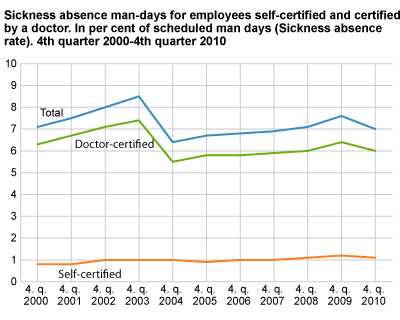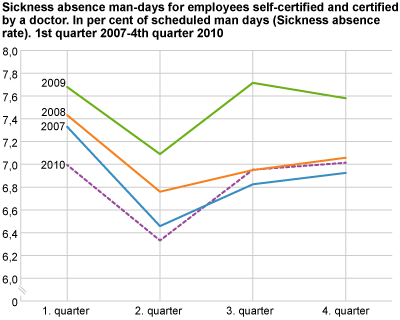Content
Published:
This is an archived release.
Decrease in sickness absence
Sickness absence fell from 7.6 to 7 per cent from the fourth quarter of 2009 to the fourth quarter of 2010; a decrease of 7.5 per cent.
This decrease may well be caused by a high level of sickness absence in 2009 due to the swine flu that year. Compared with 2008 - where there was no swine flu - the sickness absence level is unchanged.
Doctor-certified sickness absence fell from 6.4 to 6 per cent from the fourth quarter of 2009 to the fourth quarter of 2010; a reduction of 6.6 per cent. Self-certified sickness absence was reduced from 1.2 to 1.1 per cent; a reduction of 12.1 per cent.
Sickness absence in the fourth quarter of 2010 was 6.4 per cent lower than in the fourth quarter of 2001, the year of implementation of the agreement on an inclusive labour market.
Effects of swine flu
The decrease in the diagnosis group "Sickness in the bronchiae", which among other diagnoses also includes influenza, seems to explain about 65 per cent of the decrease in the doctor-certified sickness absence man-days. We do not have information about diagnoses in the self-certified sickness absence, but if we assume that all the reduction is caused by the swine flu, then about 75 per cent of the decrease in the sickness absence man-days is caused by the flu.
Statistics Norway does not have tables divided into different diagnosis groups, since we do not have access to this kind of data. We therefore refer to The Norwegian Labour and Welfare Administration .
The effect of the swine flu is difficult to estimate in different groups, such as gender, industry etc. When we, from now on, make comments on the figures, we do not take the flu into consideration, nor do we try to adjust the figures. In spite of this, we still get a clear decrease in the sickness absence in most of the groups.
Strongest reduction for men
Sickness absence for men decreased from 6.1 to 5.5 per cent from the fourth quarter of 2009 to the fourth quarter of 2010, and for women it fell from 9.4 to 8.8 per cent. This equals a percentual drop of 9.1 and 6.3 per cent respectively.
Major reduction in accommodation and food service activities
All of the industries showed a decrease in sickness absence from the fourth quarter of 2009 to the fourth quarter of 2010. Among the major industries, the decline was greatest in the accommodation and food service industry and the information and communication industry, by 14.9 and 14.3 per cent respectively. Human health and social work activities had the smallest decline, by 3.5 per cent.
Private sector had the strongest decrease
Sickness absence in the private sector had the strongest reduction by 8.2 per cent. The absences in central government (including health enterprises) and local government were reduced by 6.4 and 6.3 per cent respectively.
The sickness absence was lowest in central government and the private sector with 6.6 per cent, and highest in local government with 8.7 per cent.
Strong decrease among the youngest
Sickness absence fell within all age groups last year. The decrease for women was strongest among the youngest groups (below 25 years), with 12.4 per cent. For men, the strongest fall was in the age group below 29 years and in the age group 35-39 years.
These results are based on data on sickness absence certified by a doctor, as the survey on self-certified absence does not contain data on sickness absence by age.
Sickness absence by new industry classification dating back to the year 2000From the figures published for the first quarter of 2009, a new industry classification is in use. These will give a break in the time series for the figures by industry. Statistics Norway has calculated figures according to the new industry classification dating back to the year 2000. We refer to tables 3 and 33 under “ More tables ”.
Sickness absence according to the Labour Force Survey dating back to the year 1972The sickness absence statistics give figures dating back to the second quarter of 2000. For longer time series we must use other data sources, for instance the Labour Force Survey (LFS). Tables for sickness absence according to LFS dating back to 1972 (total figures) and 1979 (men/women) are now available in StatBank . |
Technical informationRates of change The sickness absence rates are presented using one decimal point. More decimal points are used when calculating the rates of change in order to get more accurate figures. These will therefore differ somewhat from the rates of change produced when using the published rounded figures.
The statistics do not cover self - employed persons . |
Tables:
- Table 1 Sickness absence man-days for employees self-certified and certified by a doctor. In per cent of scheduled man-days (Sickness absence rate). Quarterly figures. 2000-2010
- Table 2 Sickness absence man-days for employees self-certified and certified by a doctor, by sex. In per cent of scheduled man-days (Sickness absence rate). Quarterly figures. 2000-2010
- Table 28 Sickness absence by type of absence(self-certified or doctor-certified) and duration within the quarter
- Table 34 Cases of sickness absence and sickness absence man-days, self-certified and doctor-certified absence, by sex and duration. Per cent. Quarterly figures. 2009-2010
Tables
Contact
-
Arbeidsmarked og lønn
E-mail: arbeidsmarked@ssb.no
-
Unn H. Høydahl
E-mail: unnh.hoydahl@ssb.no
tel.: (+47) 40 90 23 77


